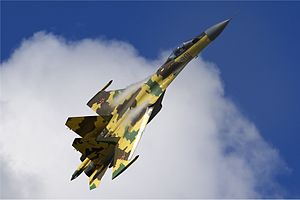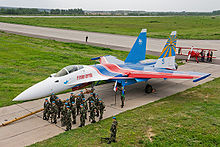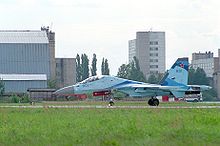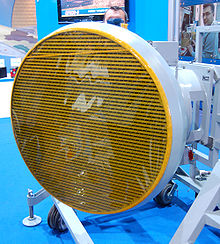Sukhoi Su-35 Videos
|
Loading...
|
|
Sukhoi Su-35
Su-35

Picture - A Su-35S of the Russian Air Force performing a demonstration at MAKS Airshow 2009.
Role: Multi-role fighter
National origin: Soviet Union / Russia
Manufacturer: Sukhoi
First flight: Su-27M/35: May 1988
Su-35S: 19 February 2008
Status: In production
Primary users: Russian Air Force
Venezuelan Air Force
Number built: Su-27M/35: 15
Su-35"BM" (from 2005): 3
Unit cost: Estimated at US$45 million to $65 million
Developed from: Sukhoi Su-27
Variants: Sukhoi Su-37
The Sukhoi Su-35 (formerly Su-27M; Cyrillic: СÑÑ Ð¾Ð¹ СÑ-35, NATO reporting name: Flanker-E) is a Russian 4+ generation heavy class, long-range, multi-role one-seat fighter prototype, that was developed from the original Su-27 fighter. Due to the similar features and components it contains, the Su-35 is considered a close cousin of the Sukhoi Su-30MKI, a modernized Su-30 variant for India.
The original Su-35 has been further developed into the Su-35BM, which has entered serial production as the Su-35S. The Su-35 is in service in small numbers with the Russian Air Force with 12 in service as of 2008.
Design and development
Su-27M/Su-35
The Su-35 is an advanced derivative of the Sukhoi Su-27, and was initially designated Su-27M. The Su-27M development began in the early 1980s. A Su-27M prototype (T-10S-70) first flew in 1988. Changes from the Su-27 include canards, upgraded engines, new radar, and a digital fly by wire flight control system. Other changes made were glass cockpit, aerial refueling probe, twin-wheel nose gear, more powerful radar, two additional underwing pylons, additional fuel capacity, and larger tail fins with horizontal carbon fibre tips.

Picture - A Russian Knights Su-35 accompanied by Russian Airborne Troops.
The first prototype was publicly displayed in 1992 at the Farnborough Airshow. Sukhoi changed its designation for the fighter from Su-27M to Su-35 in 1993. Ten prototypes Su-35s were built with four being converted Su-27s and the others being new-builds. Three production Su-27Ms were completed in 1996 and delivered to Russian Air Force (VVS) that year for testing. Five Su-35s have been used by the Russian Knights display team. In total 15 flight Su-35 (Su-27M) aircraft were produced, including a Su-35UB two-seat prototype. Two of these Su-35s were modified into Su-37s in the mid to late 1990s. The Su-35 has been nicknamed "Super Flanker".

Picture - Su-35UB landing
Although the original Su-27M/Su-35 prototype never entered serial production, many proposed improvements were incorporated into export variants of Su-27, such as Sukhoi Su-30MKI. However, the Russian Air Force did not receive the advanced variants and continued to use a Su-27 fleet procured in Soviet times, with small complements of Su-30s.
Modernization
In the mid-2000s, Sukhoi revived Su-35 concept and begun modernizing it with current technologies, with the view to replace the aging Su-27 line fighters in the Russian Air Force. The modernized Su-35 will be interim design until the fifth generation PAK FA (T-50) enters service. The modernized Su-35 has been referred to as "Su-35BM" (Bolshaya Modernizatsiya - Big Modernization) by some sources, but Sukhoi simply refers to the fighter as "Su-35". The modernized Su-35 is considered to be 4++ generation by Sukhoi.

Picture - Su-35BM at MAKS-2009
The modernized Su-35 was presented at the MAKS-2007 air show in August 2007. The new features of the aircraft include a reinforced airframe with the use of composite materials, a reduced radar signature from the front, and an improved passive electronically scanned array radar. The aircraft featured many other upgrades to its avionics and electronic systems, including digital fly-by-wire and a rear-looking radar for firing Semi-Active Radar missiles. The new Su-35 omits the canard and speedbrake; to maintain maneuverability equal to or greater than canard-equipped fighters, the Su-35 uses the hew 117S engine with fully-rotating vectoring thrust nozzles.
The new Su-35 version first flew on 19 February 2008. On 18 August 2009, the Russian Defense Ministry announced a contract for 48 Su-35S (Serial) fighters along with 16 Su-27/30 fighters to be delivered by 2015.
In September 2010 Sberbank agreed to provide funding for the Su-35 program. On 14 October 2010, Sukhoi company announced that the first production Su-35S had completed general assembly and that the first planes would be delivered to the Russian Ministry of Defense by the end of the year.
Operational history
On 14 April 2009 one Su-35BM prototype fighter crashed during a high speed ground test. The test pilot escaped unharmed after ejecting. According to Sukhoi, the fighter's brakes failed during landing, resulting in the speeding plane going off the runway and the left engine catching fire.
Orders and potential orders
In July 2008, Russia has offered the Su-35 for sale to India, Malaysia and Algeria. The Brazilian Air Force, and Venezuelan Air Force have expressed interest in purchasing Su-35s to replace their older fighters.
The Su-35BM was demonstrated at MAKS-2009 on 18 August 2009. At the same show, the Russian Air Force signed a contract for the delivery of 48 Su-35S fighters by 2015, along with 12 Su-27SM and four Su-30M2 fighters, representing the first production order for the Su-35. In November 2009 Sukhoi started implementing the state contract and the assembly of the first serial planes is scheduled for 2010.
The Su-35 is participating in Brazil's F-X2 contest. Anatoly Isaikin, general director of Rosoboronexport, declared on 6 October 2009 that the company will provide 120 fighters and a full transfer of technology. Libya is expected to sign a contract for the purchase of 12 Su-35s by end of 2010.
In November 2010, it was reported that Rosoboronexport was ready to hold talks with China on the sale of advanced Su-35 fighters to the China.
Variants
Su-27M/Su-35 Single-seat fighter. Su-35UB Two-seat fighter and trainer. Features taller vertical stabilizers and a forward fuselage similar to the Su-30. Su-35S Single-seat fighter with upgraded avionics and various modifications to the airframe. Variant was known by informal name Su-35BM originally. Su-35S is the production version ordered by Russia. Su-35K Export version of Su-35S.
Operators
Russia
Russian Air Force ordered 48 Su-35S fighters.
Venezuela
Venezuelan Air Force ordered 24 Su-35 fighters.
Specifications (Su-35S)

Picture - Radar Irbis-E for the Su-35BM at MAKS Airshow 2009
Data from KNAAPO, Gordon and Davidson, MAKS 2007 Su-35 display, aviapedia.com, milavia.net
General characteristics
Crew: 1
Length: 21.9 m (72.9 ft)
Wingspan: 15.3 m (50.2 ft)
Height: 5.90 m (19.4 ft)
Wing area: 62.0 m² (667 ft²)
Empty weight: 18,400 kg (40,570 lb)
Loaded weight: 25,300 kg (56,660 lb)
Max takeoff weight: 34,500 kg (76,060 lb)
Powerplant: 2x Saturn 117S with TVC nozzle turbofan
Dry thrust: 8,800 kgf (86.3 kN, 19,400 lbf) each
Thrust with afterburner: 14,500 kgf (142 kN, 31,900 lbf) each
Performance
Maximum speed: Mach 2.25 (2,390 km/h, 1,490 mph) at altitude
Range: 3,600 km (1,940 nmi) ; (1,580 km, 850 nmi near ground level)
Ferry range: 4,500 km (2,430 nmi) with external fuel tanks
Service ceiling: 18,000 m (59,100 ft)
Rate of climb: ;280 m/s (;55,100 ft/min)
Wing loading: 408 kg/m² (84.9 lb/ft²)
Thrust/weight: 1.1
Armament
1 x 30 mm GSh-30 internal cannon with 150 rounds
2 x wingtip rails for R-73 (AA-11 "Archer") air-to-air missiles or ECM pods
12 x wing and fuselage stations for up to 8,000 kg (17,630 lb) of ordnance, including for a variety of ordnance including air-to-air missiles, air-to-surface missiles, rockets, and bombs such as:
AA-10 Alamo: R-27R, R-27ER, R-27T, R-27ET, R-27EP, R-27AE
AA-12 Adder: R-77, and the proposed R-77M1, R-77T
AA-11 Archer: R-73E, R-73M, R-74M
AS-17 Krypton: Kh-31A, Kh-31P Anti-Radiation Missile
AS-20: Kh-59
AS-14 Kedge: Kh-29T, Kh-29L
KAB-500 Laser-guided bomb
KAB-1500 Laser-guided bomb
LGB-250 laser-guided bomb
FAB-250 250kg unguided bombs
FAB-500 500kg unguided bombs
S-25LD laser-guided rocket, S-250 unguided rocket
B-8 unguided S-8 rocket pods
B-13 unguided S-13 rocket pods
Avionics
Irbis-E passive phased array radar
4th generation jet fighter
Related development
Sukhoi Su-27
Sukhoi Su-30
Sukhoi Su-30MKI
Sukhoi Su-37
Comparable aircraft
Boeing F/A-18E/F Super Hornet
Dassault Rafale
Eurofighter Typhoon
Bibliography
Crosby, Francis. "Sukhoi SU-35". Fighter Aircraft. London: Lorenz Books, 2002. ISBN 0-7548-0990-0.
Gordon, Yefim and Peter Davison. Sukhoi Su-27 Flanker. North Branch, Minnesota: Specialty Press, 2006. ISBN 978-1-58007-091-1.
Ðakienko, Ðonstantin. "СÑ-35: ÑпаÑаÑÐµÐ»Ñ ÑÑÑÑкой авиаÑии" (in Russian). ÐÑоÑÐ¸Ð»Ñ (Profil magazine) (July 2008): 18-22.
Williams, Mel. "Sukhoi 'Super Flanker' Family". Superfighters: The Next Generation of Combat Aircraft. Norwalk, CT: AIRtime Publishing, 2002. ISBN 1-880588-53-6.
Living Warbirds: The best warbirds DVD series.
Source: WikiPedia